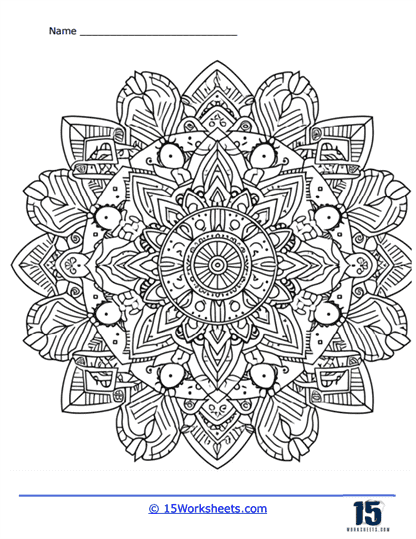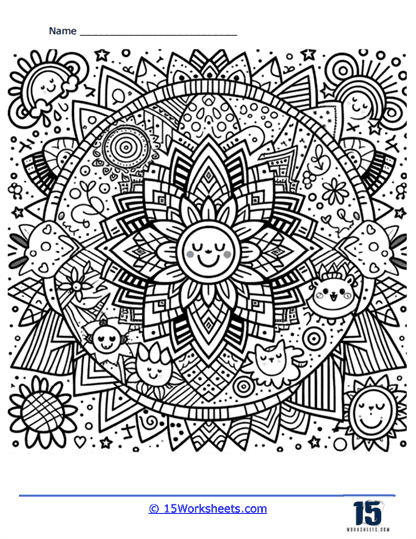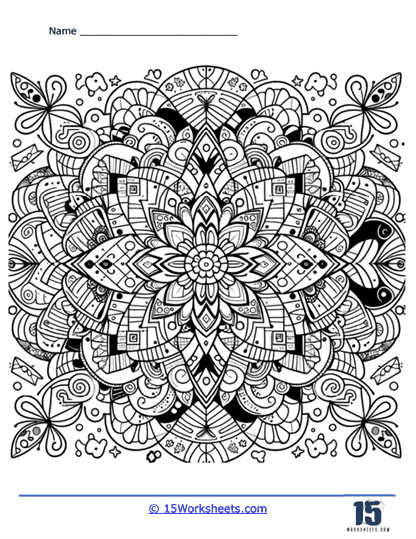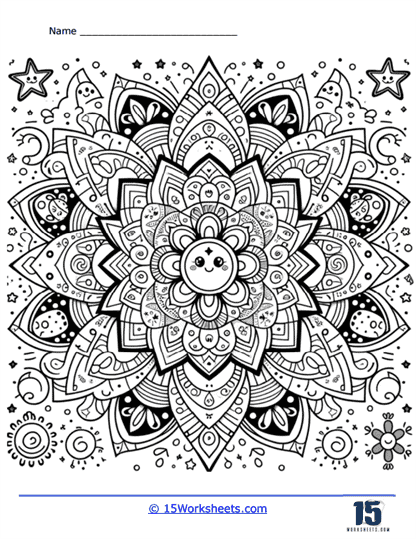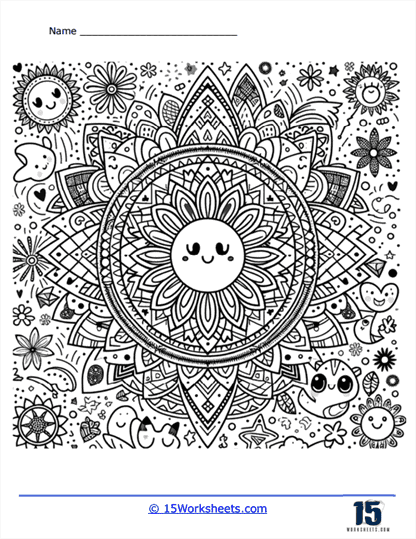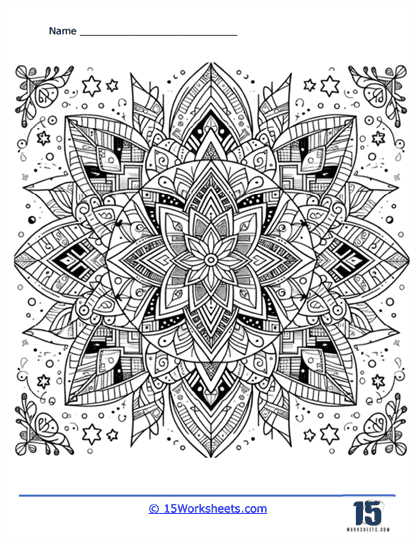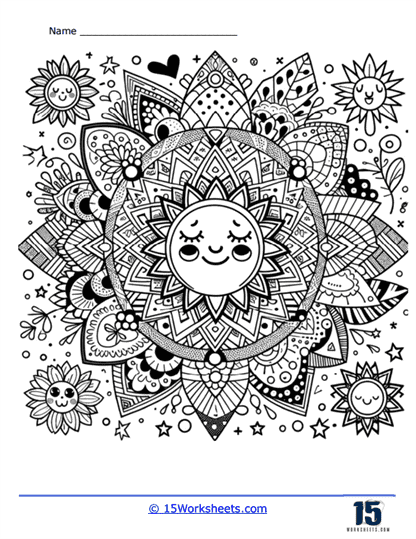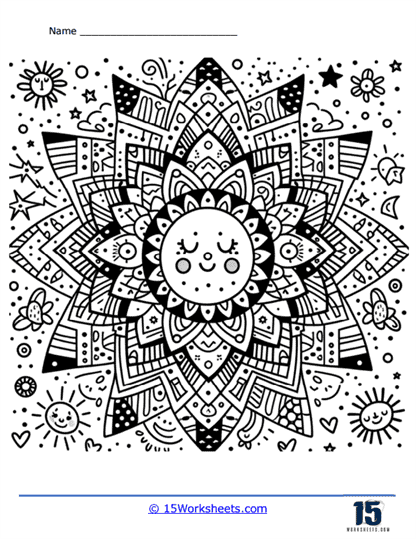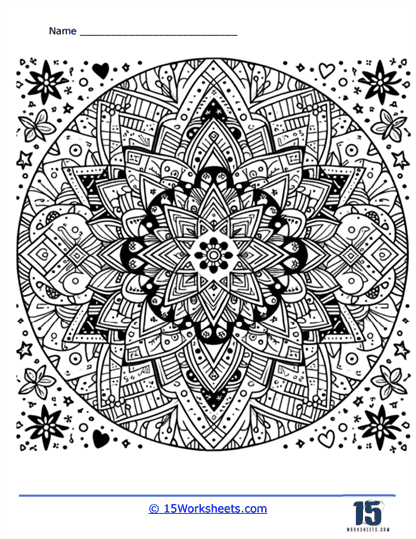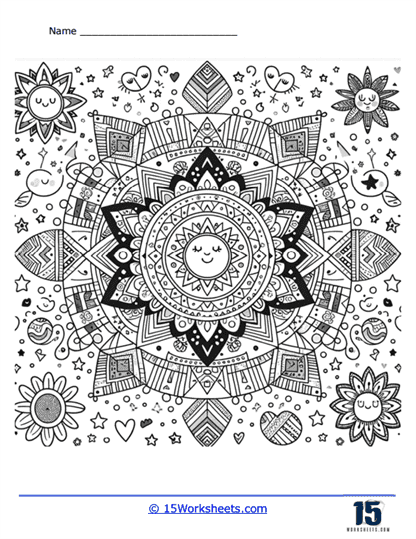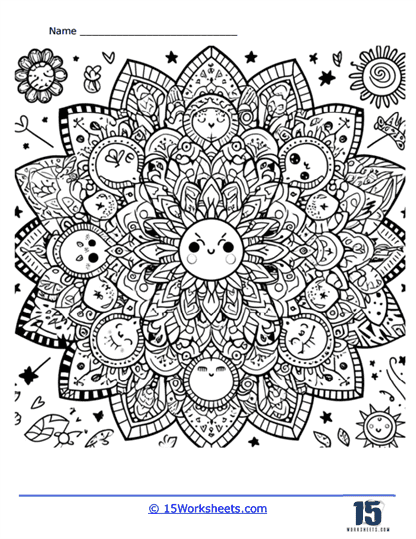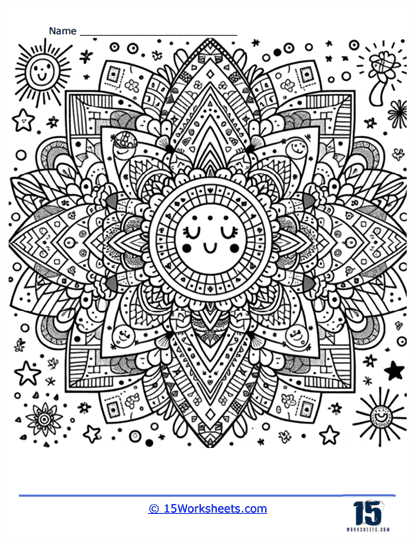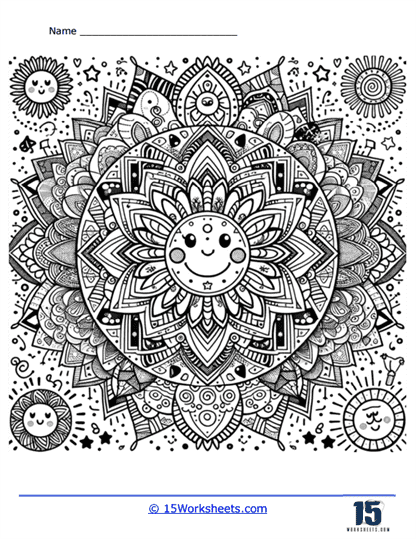Mandala Worksheets
About These 15 Worksheets
Mandala coloring pages have gained widespread popularity for their intricate designs and the calming, meditative experience they offer. Originating from the ancient Sanskrit word for “circle,” mandalas are geometric configurations of symbols and shapes that hold spiritual significance in various cultures, particularly in Hinduism and Buddhism. In the context of coloring pages, mandalas are designed to be colored in a way that promotes relaxation, focus, and creativity. These coloring pages have become a beloved pastime for both children and adults, providing a means to de-stress and engage in a mindful activity.
The variety of designs, ranging from geometric and floral patterns to animal motifs and cultural symbols, ensures that there is something to appeal to every interest and skill level. The benefits of coloring mandalas extend beyond mere entertainment, encompassing stress reduction, improved concentration, emotional healing, and educational value. Whether used as a personal hobby, a therapeutic tool, or an educational resource, mandala coloring pages provide a rich and rewarding activity that continues to captivate and inspire people of all ages. The integration of digital options further enhances their accessibility, making it easier than ever to experience the joy and tranquility of coloring mandalas.
The designs on mandala coloring pages are characterized by their symmetrical and repetitive patterns. Typically, they start with a central point, from which various shapes, symbols, and patterns radiate outward in circular symmetry. This structure is not only aesthetically pleasing but also conducive to a meditative coloring experience, as the repetitive patterns encourage a rhythmic and calming approach to coloring.
One of the most common elements found on mandala coloring pages is geometric shapes. These shapes include circles, squares, triangles, and other polygons arranged in intricate, interlocking patterns. Geometric mandalas can range from simple to highly complex designs, catering to different levels of coloring skill and patience. The simplicity of some geometric shapes can be inviting for beginners, while the more elaborate designs offer a satisfying challenge for experienced colorists.
Floral motifs are another prominent feature of mandala coloring pages. These designs incorporate various elements of nature, such as flowers, leaves, vines, and petals, arranged in symmetrical patterns. Floral mandalas often evoke a sense of natural beauty and tranquility, making them particularly appealing for those seeking a calming and aesthetically pleasing coloring experience. The intricate details of petals and leaves provide ample opportunity for creative expression, allowing colorists to experiment with different shades and color combinations.
Animal-themed mandalas are also popular, blending the symmetrical structure of mandalas with the forms of various animals. These designs might include representations of butterflies, birds, fish, or other creatures, often stylized to fit within the circular mandala format. Animal mandalas can be both whimsical and symbolic, offering a unique twist on traditional mandala designs. Coloring these pages can be especially enjoyable for animal lovers and can also serve as a way to explore the symbolism associated with different animals in various cultures.
In addition to geometric, floral, and animal designs, mandala coloring pages often feature cultural and spiritual symbols. These might include representations of deities, mythological creatures, and other icons from Hindu, Buddhist, and other spiritual traditions. For example, a mandala might incorporate the image of a lotus flower, which holds significant spiritual symbolism in many Eastern religions, representing purity and enlightenment. Other designs might include the Om symbol, intricate representations of chakras, or depictions of celestial bodies like the sun and moon. These culturally rich designs offer an opportunity to explore and appreciate the spiritual and philosophical aspects of mandalas.
These types of coloring activities can incorporate abstract patterns and designs. These abstract mandalas often focus on complex, non-representational shapes and lines that form intricate, mesmerizing patterns. The abstract nature of these designs allows for a high degree of creative freedom, as there are no specific rules or guidelines for how they should be colored. This can be particularly liberating for those who enjoy experimenting with color and form without the constraints of more representational designs.
One of the primary benefits of working with mandala coloring pages is their ability to promote relaxation and reduce stress. The repetitive, symmetrical patterns of mandalas can induce a meditative state, helping to calm the mind and reduce anxiety. This meditative aspect is rooted in the way that the brain responds to symmetry and repetition, which are naturally soothing and can help to focus the mind away from everyday worries. Coloring mandalas can serve as a form of mindfulness practice, allowing individuals to be present in the moment and engage in a peaceful, focused activity.
Another significant benefit of mandala coloring pages is their ability to enhance concentration and focus. The intricate designs require careful attention to detail, encouraging colorists to concentrate on the task at hand. This focused attention can improve cognitive function and help develop fine motor skills, especially in children. For adults, this can translate into improved problem-solving abilities and increased mental clarity. The act of selecting colors and deciding how to fill each section of the mandala also engages the creative part of the brain, fostering creativity and artistic expression.
These types of sheets can also be a valuable tool for emotional expression and healing. The process of coloring can serve as a therapeutic activity, allowing individuals to express their emotions through color and design. This can be particularly beneficial for those dealing with grief, trauma, or other emotional challenges, providing a safe and non-verbal way to process and release feelings. The act of creating something beautiful can also boost self-esteem and provide a sense of accomplishment, further contributing to emotional well-being.
In educational settings, mandala coloring pages can be used as a teaching tool to introduce concepts of symmetry, geometry, and cultural studies. Teachers can use mandalas to explain mathematical concepts such as fractions, ratios, and patterns, making learning more interactive and engaging. Additionally, mandalas can serve as a gateway to discussions about different cultures and spiritual traditions, fostering a greater appreciation for diversity and global awareness among students.
The versatility of these coloring pages makes them suitable for a wide range of settings and purposes. They can be used in therapeutic contexts, such as art therapy sessions, to help individuals explore their emotions and develop coping strategies. In wellness and mindfulness programs, mandalas can be used as a tool to teach relaxation techniques and promote mental well-being. In social settings, mandala coloring can serve as a communal activity that brings people together, whether in a family gathering, a classroom, or a community event.

